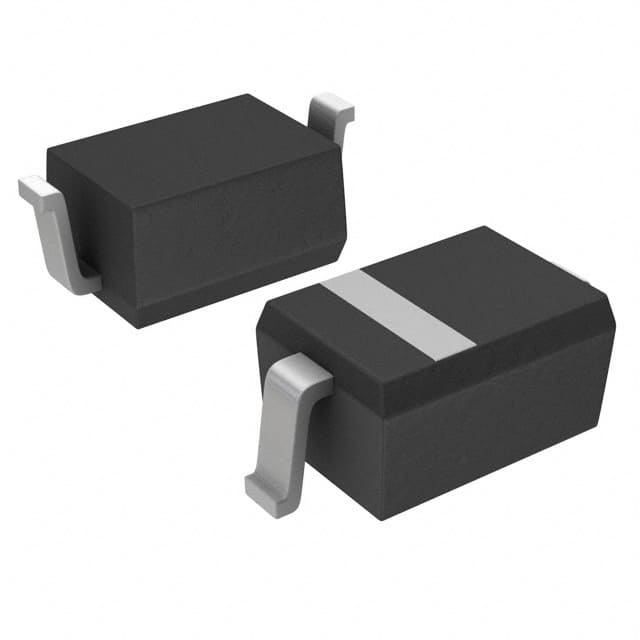MM3Z30VT1G
Introduction
The MM3Z30VT1G is a zener diode belonging to the semiconductor category. It is commonly used in electronic circuits for voltage regulation and protection against overvoltage conditions. This entry provides an overview of the basic information, specifications, pin configuration, functional features, advantages and disadvantages, working principles, application field plans, and alternative models of the MM3Z30VT1G.
Basic Information Overview
- Category: Semiconductor
- Use: Voltage regulation and overvoltage protection in electronic circuits
- Characteristics: Zener diode with a 30V breakdown voltage, low leakage current, and high reliability
- Package: SOD-323 package type
- Essence: Voltage regulation and transient voltage suppression
- Packaging/Quantity: Available in tape and reel packaging, quantity varies based on supplier
Specifications
- Breakdown Voltage: 30V
- Power Dissipation: 200mW
- Forward Voltage: 0.9V
- Reverse Leakage Current: 100nA
- Operating Temperature Range: -65°C to +150°C
Detailed Pin Configuration
The MM3Z30VT1G zener diode has a standard SOD-323 package with two pins. The cathode is connected to the marked side of the diode, while the anode is connected to the unmarked side.
Functional Features
- Voltage Regulation: Maintains a constant output voltage under varying load conditions
- Overvoltage Protection: Diverts excessive voltage away from sensitive components
- Transient Voltage Suppression: Safeguards against voltage spikes and transients
Advantages and Disadvantages
Advantages
- Precise voltage regulation
- Compact size
- Low leakage current
- High reliability
Disadvantages
- Limited power dissipation capability
- Susceptible to thermal runaway under certain conditions
Working Principles
The MM3Z30VT1G operates based on the principle of the zener effect, where it maintains a nearly constant voltage across its terminals when reverse-biased. When the voltage across the diode reaches the breakdown voltage of 30V, it conducts heavily, effectively regulating the voltage across the circuit.
Detailed Application Field Plans
The MM3Z30VT1G is widely used in various electronic applications, including: - Voltage regulators in power supplies - Overvoltage protection in consumer electronics - Signal clamping and transient suppression in communication systems - Voltage reference in precision measurement equipment
Detailed and Complete Alternative Models
Some alternative models to the MM3Z30VT1G include: - BZX84C30LT1G - MMBZ27VCLT1G - PZM30NB1,115 - BZT52C30S-7-F
In conclusion, the MM3Z30VT1G zener diode offers precise voltage regulation and overvoltage protection in a compact and reliable package, making it suitable for a wide range of electronic applications.
Word Count: 398
قم بإدراج 10 أسئلة وإجابات شائعة تتعلق بتطبيق MM3Z30VT1G في الحلول التقنية
What is the MM3Z30VT1G?
- The MM3Z30VT1G is a 30V Zener diode designed for voltage regulation and protection in various electronic circuits.
What are the typical applications of MM3Z30VT1G?
- The MM3Z30VT1G is commonly used in voltage reference, voltage clamping, and voltage regulation circuits in electronic devices.
What is the maximum power dissipation of MM3Z30VT1G?
- The maximum power dissipation of MM3Z30VT1G is typically around 200mW.
What is the voltage tolerance of MM3Z30VT1G?
- The voltage tolerance of MM3Z30VT1G is typically ±5%.
What is the operating temperature range of MM3Z30VT1G?
- The operating temperature range of MM3Z30VT1G is usually between -65°C to +150°C.
Can MM3Z30VT1G be used for overvoltage protection?
- Yes, MM3Z30VT1G can be used for overvoltage protection by connecting it in parallel with the circuit to be protected.
Is MM3Z30VT1G suitable for low-power applications?
- Yes, MM3Z30VT1G is suitable for low-power applications due to its low power dissipation.
What is the package type of MM3Z30VT1G?
- MM3Z30VT1G is available in a small SOD-323 surface mount package.
Can MM3Z30VT1G be used in reverse bias?
- Yes, MM3Z30VT1G can be used in reverse bias as a voltage regulator or reference.
Are there any specific layout considerations for using MM3Z30VT1G?
- It's important to minimize lead lengths and keep the device close to the load to reduce parasitic effects and ensure stable operation.


